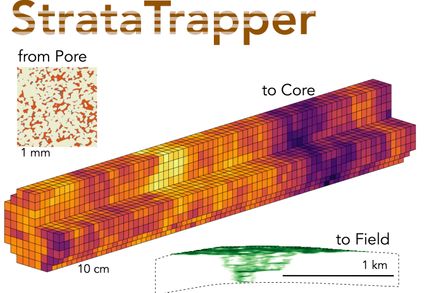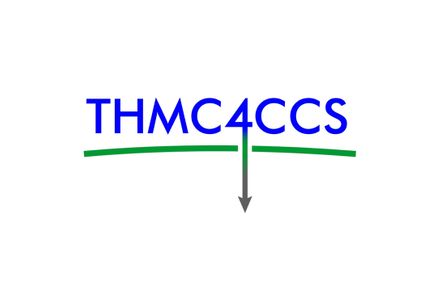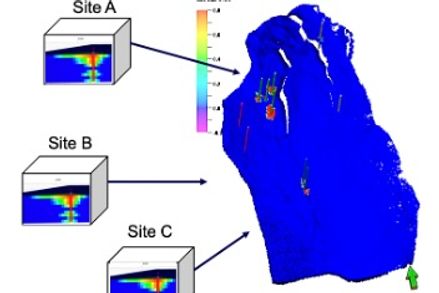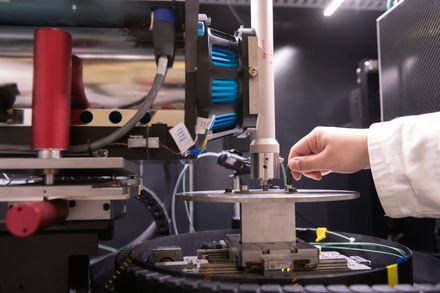Research
We investigate the physics, chemistry, and techno-economics of CO2 storage underground
Our research includes exploring fundamental pore scale fluid dynamics, developing digital rocks analysis techniques, increasing the accuracy of field scale reservoir simulation, and evaluating the feasibility of scaling up CO2 storage to climate relevant scales.
Our Research Projects

StrataTrapper Advanced Modelling of CO2 Migration and Trapping

THMC4CCS: ThorougH experiMental and numerical investigation of Coupled processes for geologiC Carbon Storage
Results
- Showing results for:
- Reset all filters
Search results
-
Journal articleLin Q, Bijeljic B, Pini R, et al., 2018,
Imaging and measurement of pore‐scale interfacial curvature to determine capillary pressure simultaneously with relative permeability
, Water Resources Research, Vol: 54, Pages: 7046-7060, ISSN: 0043-1397There are a number of challenges associated with the determination of relative permeability and capillary pressure. It is difficult to measure both parameters simultaneously on the same sample using conventional methods. Instead, separate measurements are made on different samples, usually with different flooding protocols. Hence, it is not certain that the pore structure and displacement processes used to determine relative permeability are the same as those when capillary pressure was measured. Moreover, at present, we do not use pore‐scale information from high‐resolution imaging to inform multiphase flow properties directly. We introduce a method using pore‐scale imaging to determine capillary pressure from local interfacial curvature. This, in combination with pressure drop measurements, allows both relative permeabilities and capillary pressure to be determined during steady state coinjection of two phases through the core. A steady state waterflood experiment was performed in a Bentheimer sandstone, where decalin and brine were simultaneously injected through the core at increasing brine fractional flows from 0 to 1. The local saturation and the curvature of the oil‐brine interface were determined. Using the Young‐Laplace law, the curvature was related to a local capillary pressure. There was a detectable gradient in both saturation and capillary pressure along the flow direction. The relative permeability was determined from the experimentally measured pressure drop and average saturation obtained by imaging. An analytical correction to the brine relative permeability could be made using the capillary pressure gradient. The results for both relative permeability and capillary pressure are consistent with previous literature measurements on larger samples.
-
Journal articleKirby M, Simperler A, Krevor S, et al., 2018,
Computational tools for calculating log β values of geochemically relevant uranium organometallic complexes
, Journal of Physical Chemistry A, Vol: 122, Pages: 8007-8019, ISSN: 1089-5639Uranium (UVI) interacts with organic ligands, subsequently controlling its aqueous chemistry. It is therefore imperative to assess the binding ability of natural organic molecules. We evidence that density functional theory (DFT) can be used as a practical protocol for predicting the stability of UVI organic ligand complexes, allowing for the development of a relative stability series for organic complexes with limited experimental data. Solvation methods and DFT settings were benchmarked to suggest a suitable off-the-shelf solution. The results indicate that the IEFPCM solvation method should be employed. A mixed solvation approach improves the accuracy of the calculated stability constant (log β); however, the calculated log β are approximately five times more favorable than experimental data. Different basis sets, functionals, and effective core potentials were tested to check that there were no major changes in molecular geometries and ΔrG. The recommended method employed is the B3LYP functional, aug-cc-pVDZ basis set for ligands, MDF60 ECP and basis set for UVI, and the IEFPCM solvation model. Using the fitting approach employed in the literature with these updated DFT settings allows fitting of 1:1 UVI complexes with root-mean-square deviation of 1.38 log β units. Fitting multiple bound carboxylate ligands indicates a second, separate fitting for 1:2 and 1:3 complexes.
-
Conference paperSonnenberg J, Kirby M, Simperler A, et al., 2018,
Towards stability constant prediction in uranium siderophore complexes
, 256th National Meeting and Exposition of the American-Chemical-Society (ACS) - Nanoscience, Nanotechnology and Beyond, Publisher: AMER CHEMICAL SOC, ISSN: 0065-7727 -
Conference paperMuggeridge AH, Alshawaf M, Krevor S, 2018,
Experimental Investigation of Cross-flow in Stratified Reservoirs During Polymer Flooding
, SPE IMproved Oil Recovery Conference -
Journal articleJackson S, Agada S, Reynolds C, et al., 2018,
Characterizing drainage multiphase flow in heterogeneous sandstones
, Water Resources Research, Vol: 54, Pages: 3139-3161, ISSN: 0043-1397In this work, we analyze the characterization of drainage multiphase flow properties on heterogeneous rock cores using a rich experimental data set and mm‐m scale numerical simulations. Along with routine multiphase flow properties, 3‐D submeter scale capillary pressure heterogeneity is characterized by combining experimental observations and numerical calibration, resulting in a 3‐D numerical model of the rock core. The uniqueness and predictive capability of the numerical models are evaluated by accurately predicting the experimentally measured relative permeability of N2—DI water and CO2—brine systems in two distinct sandstone rock cores across multiple fractional flow regimes and total flow rates. The numerical models are used to derive equivalent relative permeabilities, which are upscaled functions incorporating the effects of submeter scale capillary pressure. The functions are obtained across capillary numbers which span four orders of magnitude, representative of the range of flow regimes that occur in subsurface CO2 injection. Removal of experimental boundary artifacts allows the derivation of equivalent functions which are characteristic of the continuous subsurface. We also demonstrate how heterogeneities can be reorientated and restructured to efficiently estimate flow properties in rock orientations differing from the original core sample. This analysis shows how combined experimental and numerical characterization of rock samples can be used to derive equivalent flow properties from heterogeneous rocks.
-
Journal articleBui M, Adjiman CS, Bardow A, et al., 2018,
Carbon capture and storage (CCS): the way forward
, Energy and Environmental Science, Vol: 11, Pages: 1062-1176, ISSN: 1754-5692Carbon capture and storage (CCS) is broadly recognised as having the potential to play a key role in meeting climate change targets, delivering low carbon heat and power, decarbonising industry and, more recently, its ability to facilitate the net removal of CO2 from the atmosphere. However, despite this broad consensus and its technical maturity, CCS has not yet been deployed on a scale commensurate with the ambitions articulated a decade ago. Thus, in this paper we review the current state-of-the-art of CO2 capture, transport, utilisation and storage from a multi-scale perspective, moving from the global to molecular scales. In light of the COP21 commitments to limit warming to less than 2 °C, we extend the remit of this study to include the key negative emissions technologies (NETs) of bioenergy with CCS (BECCS), and direct air capture (DAC). Cognisant of the non-technical barriers to deploying CCS, we reflect on recent experience from the UK's CCS commercialisation programme and consider the commercial and political barriers to the large-scale deployment of CCS. In all areas, we focus on identifying and clearly articulating the key research challenges that could usefully be addressed in the coming decade.
-
Journal articleReynolds C, Blunt MJ, Krevor SC, 2018,
Multiphase flow characteristics of heterogeneous rocks from CO2 storage reservoirs in the United Kingdom
, Water Resources Research, Vol: 54, Pages: 729-745, ISSN: 0043-1397We have studied the impact of heterogeneity on relative permeability and residual trapping for rock samples from the Bunter sandstone of the UK Southern North Sea, the Ormskirk sandstone of the East Irish Sea, and the Captain sandstone of the UK Northern North Sea. Reservoir condition CO2-brine relative permeability measurements were made while systematically varying the ratio of viscous to capillary flow potential, across a range of flow rates, fractional flow, and during drainage and imbibition displacement. This variation resulted in observations obtained across a range of core-scale capillary number math formula. Capillary pressure heterogeneity was quantitatively inferred from 3-D observations of the fluid saturation distribution in the rocks. For each of the rock samples, a threshold capillary number, math formula, was found, below which centimeter-scale layering resulted in a heterogeneous distribution of the fluid phases and a commensurate impact on flow and trapping. The threshold was found to be dependent on the capillary number alone, irrespective of the displacement path (drainage or imbibition) and average fluid saturation in the rock. The impact of the heterogeneity on the relative permeability varied depending on the characteristics of the heterogeneity in the rock sample, whereas heterogeneity increased residual trapping in all samples above what would be expected from the pore-scale capillary trapping mechanism alone. Models of subsurface CO2 injection should use properties that incorporate the impacts of heterogeneity at the flow regime of interest or risk significant errors in estimates of fluid flow and trapping.
-
Conference paperJackson S, Mayachita I, Krevor S, 2018,
High resolution modelling and steady-state upscaling of large scale gravity currents in heterogeneous sandstone reservoirs
We investigate the impact of small-scale heterogeneities (<10m) and gravity on large scale O(100m) lateral CO2 plume migration at varying capillary number, Nc and gravity number, Ngv. For isotopically correlated heterogeneities, plume migration was slowed signicantly at low Nc and high Ngv. For anisotropic cases akin to sedimentary geological structures, the plume speed was correspondingly enhanced, with breakthrough times reduced by up to 20% at large correlation lengths. Using relative measures, the capillary pressure was found to be the major control on plume migration as opposed to permeability, at low Nc. Using single, homogenized upscaled functions, we were able to capture the effects of small scale heterogeneities at low or high Nc and moderate Ngv. However, the relative enhancement of the impact of heterogeneities at high Ngv (and low Nc) could not be captured using single homogeneous functions for the entire domain. Without including enhanced gravity effects in the upscaling procedure, which generate anisotropic upscaled functions, the full effects of small-scale heterogeneities in gravity segregated flow could be signicantly underestimated in large scale models, leading to inaccurate plume migration estimates.
-
Conference paperDe Simone S, Jackson SJ, Zimmerman RW, et al., 2018,
Analysis of the use of superposition for analytic models of CO2 injection into reservoirs with multiple injection sites
Large scale CCS is crucial to reduce the cost associated with minimizing climate change. Energy system models should thus include CCS at regional or global scale with a proper evaluation of pressure limitations and injectivity, which are currently ignored. To this aim, the use of simplified analytical solutions is highly useful because they provide fast evaluation of pressure and plume evolution without the computational costs of the numerical models. Application of these solutions to assess storage capacity has been extended to cases of multiple well injection. In these cases, the pressure build-up is evaluated as the superposition of the analytical solutions for pressure associated with each individual well. In this study we investigate the validity of the superposition procedure, given the non-linearity of the multiphase flow. We quantify the error associated with the application of superposition to estimate reservoir pressurisation in different scenarios of.multi-site CO2 injection in a large regional aquifer. We find that the error associated with the adoption of this procedure increases with time and with the number of wells in proportion to the area invaded by CO2 in the reservoir.
-
Journal articleReynolds C, Blunt M, Krevor S, 2017,
Multiphase flow characteristics of heterogeneous rocks from CO2 storage reservoirs in the United Kingdom
<jats:p>We have studied the impact of heterogeneity on relative permeability and residual trapping for rock samples from the Bunter sandstone of the UK Southern North Sea, the Ormskirk Sandstone of the East Irish Sea, and the Captain Sandstone of the UK Northern North Sea. Reservoir condition CO2-brine relative permeability measurements were made while systematically varying the ratio of viscous to capillary flow potential, across a range of flow rates, fractional flow, and during drainage and imbibition displacement. This variation resulted in observations obtained across a range of core-scale capillary number 0.2 &lt; Nc &lt; 200. Capillary pressure heterogeneity was quantitatively inferred from 3D observations of the fluid saturation distribution in the rocks. For each of the rock samples a threshold capillary number, 5 &lt; Nc &lt; 30, was found, below which centimetre-scale layering resulted in a heterogeneous distribution of the fluid phases and a commensurate impact on flow and trapping. The threshold was found to be dependent on the capillary number alone, irrespective of the displacement path (drainage or imbibition) and average fluid saturation in the rock. The impact of the heterogeneity on the relative permeability varied depending on the characteristics of the heterogeneity in the rock sample, whereas heterogeneity increased residual trapping in all samples above what would be expected from the pore-scale capillary trapping mechanism alone. Models of subsurface CO2 injection should use properties that incorporate the impacts of heterogeneity at the flow regime of interest or risk significant errors in estimates of fluid flow and trapping.</jats:p>
This data is extracted from the Web of Science and reproduced under a licence from Thomson Reuters. You may not copy or re-distribute this data in whole or in part without the written consent of the Science business of Thomson Reuters.






